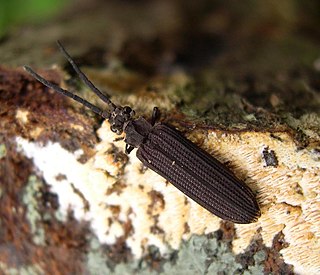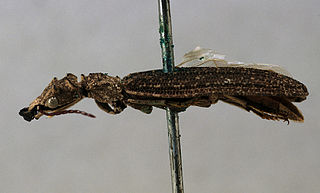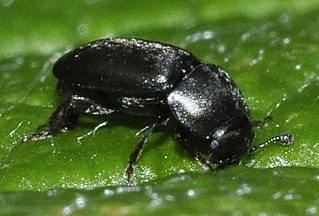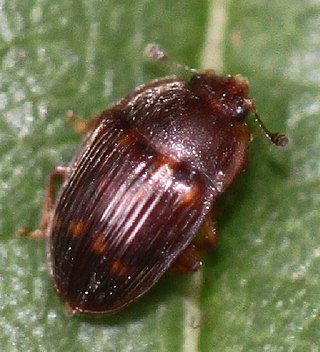Related Research Articles

The sap beetles, also known as Nitidulidae, are a family of beetles.

The Cupedidae are a small family of beetles, notable for the square pattern of "windows" on their elytra, which give the family their common name of reticulated beetles.

Cucujoidea is a superfamily of beetles. This group formerly included all of the families now included in the superfamily Coccinelloidea. They include some fungus beetles and a diversity of lineages of "bark beetles" unrelated to the "true" bark beetles (Scolytinae), which are weevils.

Lepicerus is a genus of myxophagan beetles containing three described species in the family Lepiceridae; it is the only extant genus in the family, with another genus, Lepiceratus only known from fossils. Extant species occur in the Neotropics, from Mexico south to Venezuela and Ecuador. Fossils referrable to the genus are known from the early Late Cretaceous of Southeast Asia.

The Ommatidae are a family of beetles in the suborder Archostemata. The Ommatidae are considered the extant beetle family that has most ancestral characteristics. There are only seven extant species, confined to Australia and South America. However, the geographical distribution was much wider during the Mesozoic spanning across Eurasia and Australia, suggesting that they were widespread on Pangea. So far, over 26 extinct genera containing over 170 species of these beetles have been described. Three extant genera have been assigned to this family: Omma,Tetraphalerus and Beutelius. The family is considered to be a subfamily of Cupedidae by some authors, but have been found to be more closely related to Micromalthidae in molecular phylogenies. A close relationship with Micromalthidae is supported by several morphological characters, including those of the mandibles and male genitalia. Due to their rarity, their ecology is obscure, it is likely that their larvae feed on deadwood.

Helotidae is a family of beetles, in the suborder Polyphaga. The family includes about five extant genera, Helota MacLeay, Neohelota Ohta, Afrohelotina Kirejtshuk, Metahelotella Kirejtshuk, and Strophohelota Kirejtshuk. Helotidae are found mainly in the Old World tropics and are absent from Australia and Madagascar. The antennae are clubbed on the final three segments and is retractable within grooves under the head. The wings have reduced venation with just 4 anal veins. Helotids are known to be associated with sap, fruit and flowers, and the larvae of some species are known to bore into wood in order to pupate.

Glischrochilus is a genus of sap-feeding and predatory beetles under the family Nitidulidae, subfamily Cryptarchinae. Most members of this genus are commonly known as picnic beetles or beer bugs.

Byrrhidae, the pill beetles, is a family of beetles in the superfamily Byrrhoidea. They are generally found in damp habitats within cooler-high latitude regions of both hemispheres. Most byrrhids feed on moss, lichens and algae, though some species feed on vascular plants. The oldest undoubted record of the family is Lidryops from the earliest Late Cretaceous Charentese amber of France, with other less certain records going back to the Middle Jurassic, but these possibly belong to Byrrhoidea. There around 500 extant species in 40 genera.

The Brachypsectridae are a family of beetles commonly known as the Texas beetles. There are only two extant genera, Brachypsectra and Asiopsectra. Brachypsectra has a cosmopolitan distribution, mostly in arid regions, while Asiopsectra is found in Central Asia and the Middle East.

Carpophilinae is a subfamily of beetles in the family Nitidulidae. There are at least 70 described species in Carpophilinae.

Cybocephalidae is a family of sap, bark and fungus beetles in the order Coleoptera with a wide global distribution. The type genus Cybocephalus has more than 200 species in it and the entire family has about 220 species in all. Many species are predators of armoured scale insects (Diaspididae). There are four tarsal segments on all the legs. The body is only slightly longer than wide and very convex and shiny. They are small and about 1 to 3 mm long. The insect can roll into a ball like position with its downward facing head. The tarsomeres are lobed underneath. The family is sometimes treated as a subfamily within the Nitudulidae.

Nitidulinae is a subfamily of sap-feeding beetles in the family Nitidulidae. There are about 17 genera and at least 70 described species in Nitidulinae.

Meligethes is a genus of pollen beetles in the family Nitidulidae. There are more than 80 described species in Meligethes.

Amphicrossus is a genus of sap-feeding beetles in the family Nitidulidae. There are about nine described species in Amphicrossus.

Cyllodes is a genus of sap-feeding beetles in the family Nitidulidae. There are about 14 described species in Cyllodes.

Soronia is a genus of sap-feeding beetles in the family Nitidulidae. There are about 14 described species in Soronia.

Urophorus is a genus of sap-feeding beetles in the family Nitidulidae. There are at least two described species in Urophorus.

Phenolia is a genus of sap-feeding beetles in the family Nitidulidae. There are about nine described species in Phenolia.

Stelidota is a genus of sap-feeding beetles in the family Nitidulidae. There are about 15 described species in Stelidota.

Stefan Misko was a Ukrainian-born entomologist, painter and community leader who lived and worked in Australia. He was founder and president of the Ukrainian Artists Society of Australia and was director-owner of an art gallery in Canberra.
References
- 1 2 3 Kirejtshuk, A.G.; Lawrence, J.F. 1992: Cychramptodini, a new tribe of Nitidulidae (Coleoptera) from Australia. Journal of the Australian Entomological Society, 31: 29–46. https://doi.org/10.1111/j.1440-6055.1992.tb00456.x